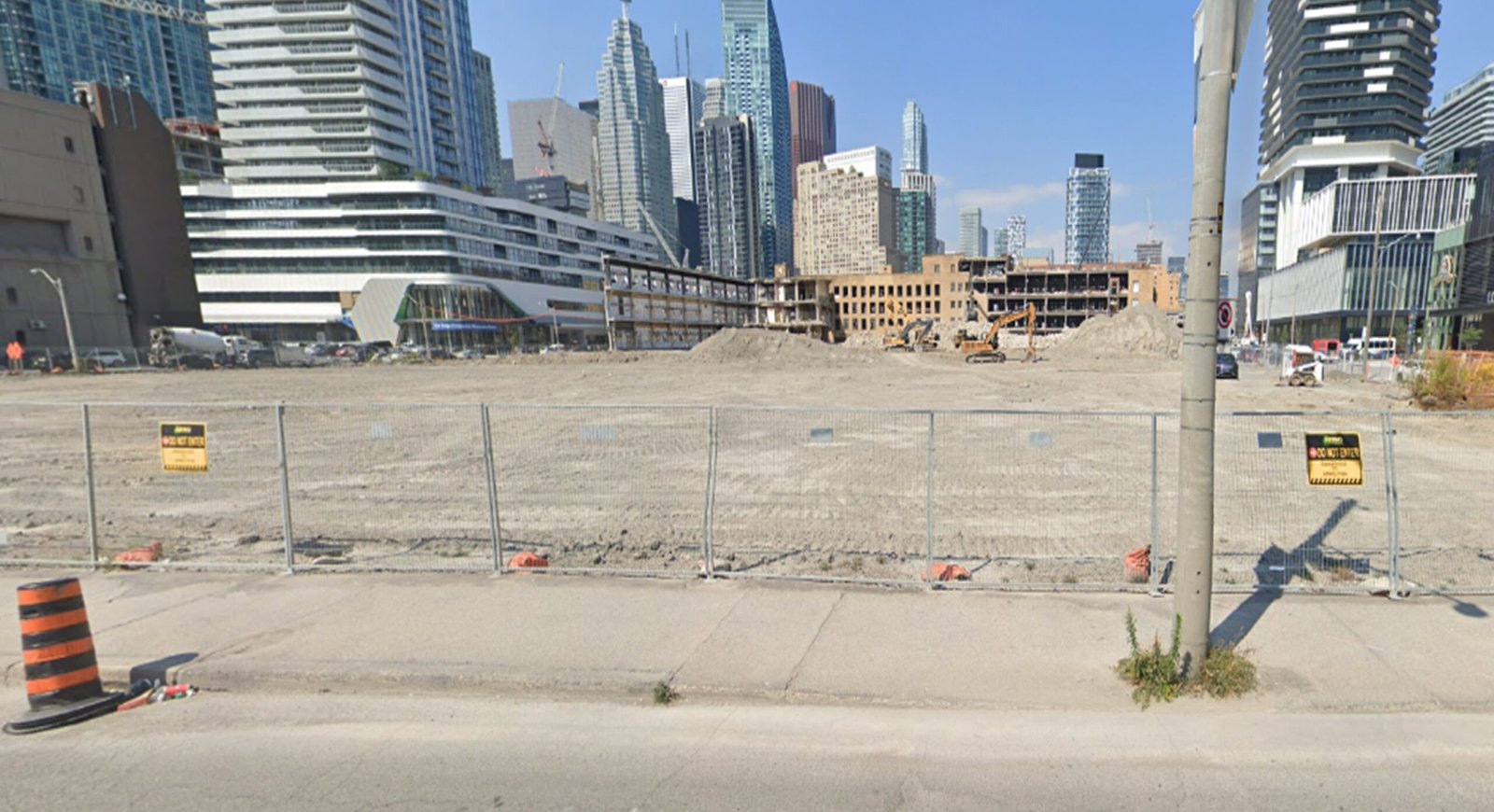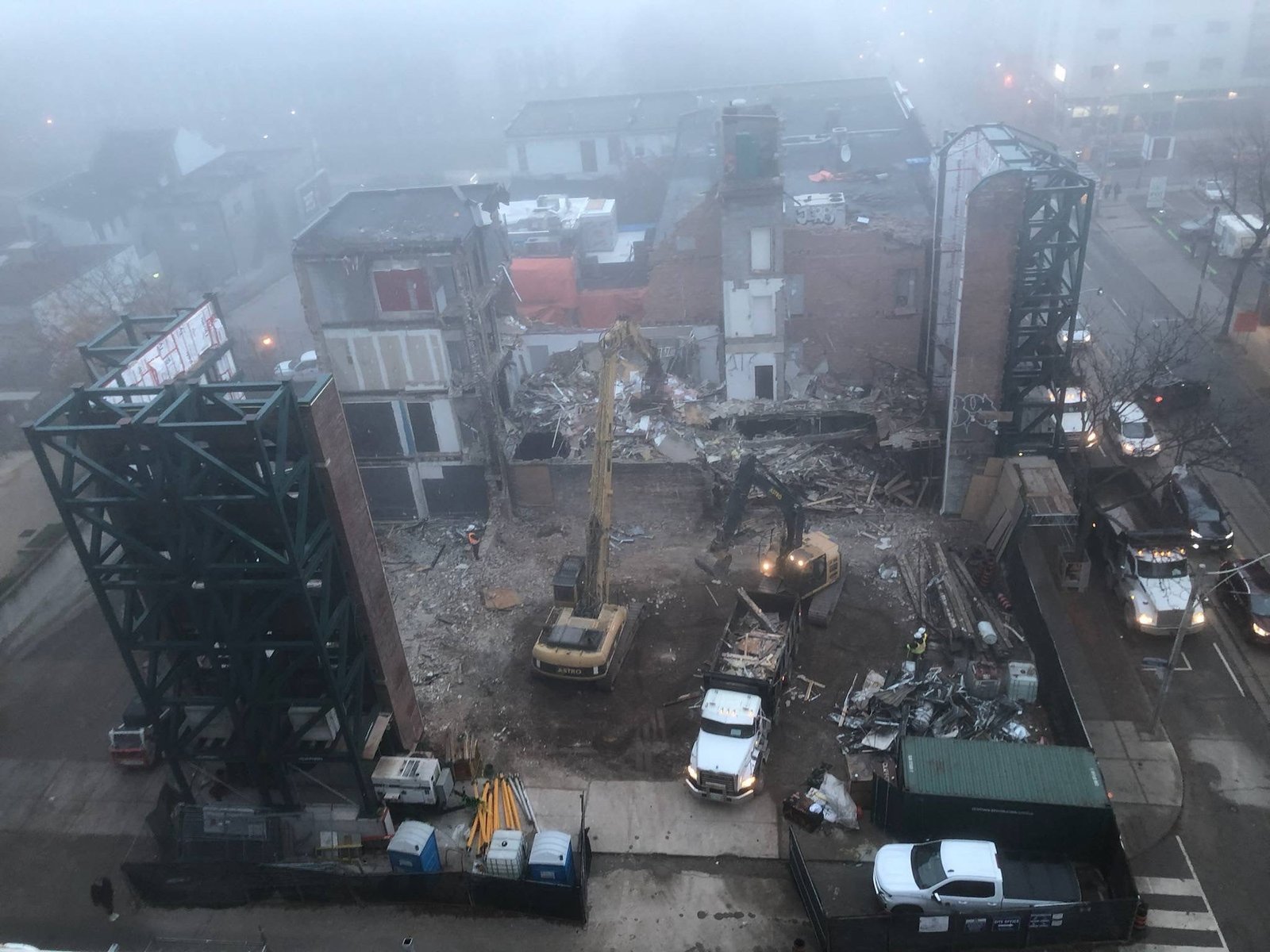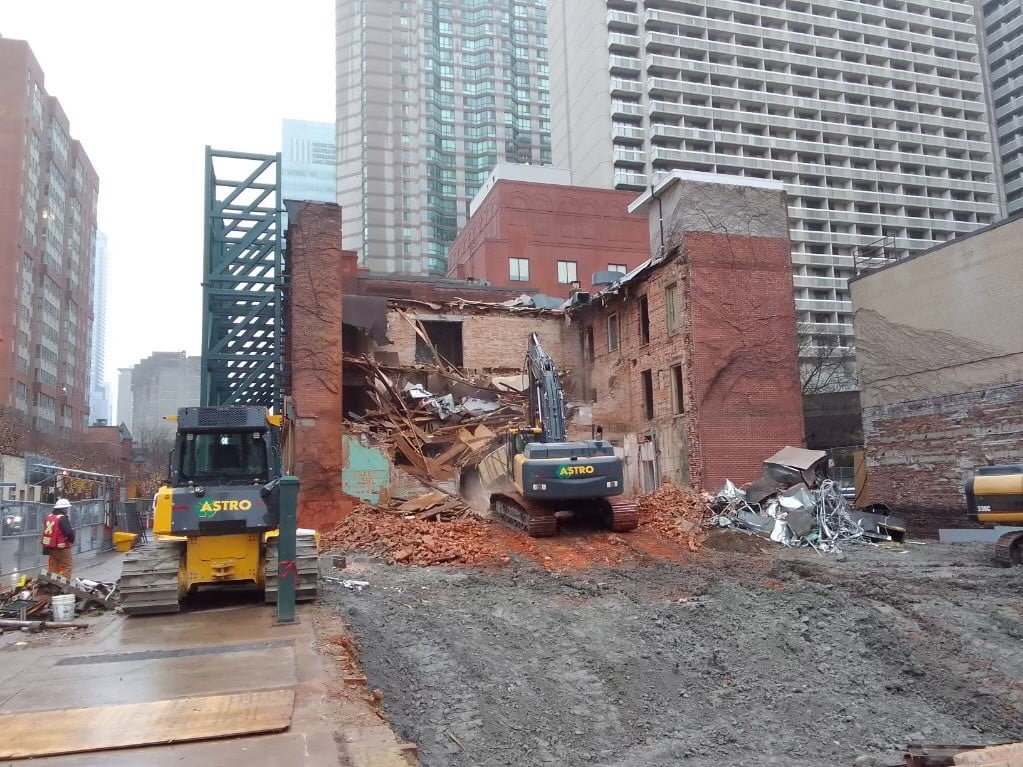Heritage Sensitive Demolition
Discover How Astro Environmental Can Help You With Safe, Efficient, and Professional Demolition
What Is Heritage Sensitive Demolition?
Heritage-sensitive demolition refers to the process of demolishing a historic or culturally significant building while considering its architectural, historical, and cultural value. It involves careful planning, documentation, and preservation of important features or materials that can be salvaged or reused.
The goal of heritage-sensitive demolition is to minimize the loss of important heritage elements and ensure the preservation of the building’s historical significance. This can involve techniques such as deconstruction, where materials are carefully dismantled and salvaged for reuse, rather than completely demolished.
Heritage-sensitive demolition also includes documenting the building’s history, architecture, and unique features before demolition begins. This documentation can be used for future reference, research, or reconstruction purposes.
By considering the heritage value of a building during the demolition process, heritage-sensitive demolition aims to strike a balance between development needs and preserving cultural heritage. It allows for the incorporation of historical elements into new construction projects or the creation of commemorative spaces that honor the history of the demolished building.
What Is The Heritage Sensitive Demolition Process?
The Heritage-Sensitive Demolition Process is a specific approach to demolition that takes into consideration the historical and cultural significance of a building or site. It involves careful planning, assessment, and management of the demolition process to minimize damage to heritage assets and preserve as much of the historical fabric as possible.
By following the Heritage-Sensitive Demolition Process, it is possible to balance the need for development and progress with the preservation of our historical and cultural heritage.

When Is Heritage Sensitive Demolition Necessary?

Heritage-sensitive demolition is necessary when a building or structure holds significant historical, cultural, or architectural value that should be preserved. Situations where heritage-sensitive demolition may be required include unsafe buildings, conservation or redevelopment projects, urban planning and infrastructure development, and irreparable damage from natural disasters. However, it should be considered as a last resort after exploring all other options for preservation or adaptive reuse. Consultation with heritage experts and community stakeholders is important to minimize the loss of cultural or historical significance.
What Are Important Considerations?
Important considerations for heritage-sensitive demolition include understanding the historical significance of the building, familiarizing oneself with heritage regulations, engaging stakeholders, documenting the site before demolition, salvaging and reusing elements, implementing mitigative measures, reinterpreting and commemorating the site, considering sustainable practices, involving public consultation, and conducting post-demolition monitoring. These considerations aim to preserve the historical value and minimize the impact of demolition on the surrounding environment and community.

The Heritage Sensitive Demolition Process
Preliminary Assessment
The first step is to conduct a preliminary assessment of the building or site to identify any historical or cultural significance. This may involve researching archival records, consulting with heritage experts, or conducting on-site surveys.
Heritage Impact Assessment
Once the significance of the building or site is identified, a detailed heritage impact assessment is conducted. This assessment evaluates the potential impact of the proposed demolition on the heritage values, including architectural features, materials, and historical context.
Mitigation Measures
Based on the heritage impact assessment, mitigation measures are developed to minimize the impact on the heritage values. These measures may include salvaging significant architectural elements, documenting the building or site through photography or 3D scanning, or integrating heritage interpretation into the new development.
Stakeholder Consultation
Throughout the process, engagement with stakeholders, such as heritage organizations, local communities, and government agencies, is crucial. Their input and feedback help inform decision-making and ensure that the demolition process considers their concerns and interests.
Permitting & Approvals
Depending on the jurisdiction, obtaining permits and approvals from relevant authorities may be required before proceeding with the demolition. This includes heritage authorities, local planning departments, and other regulatory bodies.
Demolition Execution
Once all necessary permits and approvals are obtained, the demolition is carried out following the prescribed methodology. This involves employing skilled professionals who understand and adhere to the heritage-sensitive approach, using appropriate techniques and equipment to minimize damage to heritage assets.
Post-Demolition Documentation
After the demolition is completed, a detailed documentation process takes place. This includes recording the building or site’s condition before, during, and after demolition, as well as archiving any salvaged materials or significant architectural features.
Frequently Asked Questions About Heritage Demolition
How does heritage-sensitive demolition differ from regular demolition?
Heritage-sensitive demolition differs from regular demolition in several ways:
1. Preservation of historical and cultural significance: Heritage-sensitive demolition takes into account the historical and cultural value of a building or structure. It aims to preserve and protect elements that have historical, architectural, or cultural significance.
2. Salvaging and reusing materials: Heritage-sensitive demolition focuses on salvaging and reusing materials whenever possible. This includes architectural elements, fixtures, and other components that can be incorporated into new construction or repurposed elsewhere.
3. Documentation and record-keeping: Prior to demolition, heritage-sensitive practices involve thorough documentation and record-keeping of the building's history, architectural details, and any significant features. This information is important for future research, reconstruction, or replication purposes.
4. Expert assessment and consultation: Heritage-sensitive demolition often involves consultation with experts such as historians, architects, and conservationists who can provide guidance on preserving important elements or finding alternative solutions to demolition.
5. Compliance with heritage regulations: Regular demolition may not be subject to specific regulations related to heritage preservation. However, heritage-sensitive demolition must comply with local heritage preservation laws and regulations to ensure that the historical and cultural significance of the building or structure is respected and protected.
6. Adaptive reuse or reconstruction: In cases where complete demolition is not necessary, heritage-sensitive practices may promote adaptive reuse or reconstruction of the building or structure. This involves repurposing the space for different functions while retaining its historical character.
Overall, heritage-sensitive demolition prioritizes the preservation of historical and cultural value, promotes sustainability through material salvage and reuse, and ensures compliance with heritage preservation regulations.
What are the benefits of heritage-sensitive demolition?
The benefits of heritage-sensitive demolition include:
1. Preservation of historical and cultural significance: Heritage-sensitive demolition ensures that the historical and cultural value of a building or structure is not lost. It allows for the retention and interpretation of important architectural, artistic, or historical elements, contributing to the preservation of local heritage.
2. Sustainable reuse of materials: By carefully dismantling a historic building, heritage-sensitive demolition allows for the salvage and reuse of valuable materials. This reduces waste and promotes sustainability in construction by minimizing the need for new resources.
3. Economic benefits: Preserving and restoring historic buildings can have positive economic impacts on communities. They often attract tourists, businesses, and investors, contributing to job creation, increased property values, and the revitalization of local economies.
4. Educational opportunities: Heritage-sensitive demolition provides educational opportunities for both locals and visitors. By preserving significant elements of a building or structure, it allows for the interpretation and understanding of historical, architectural, or cultural aspects, thereby enhancing public knowledge and appreciation of heritage.
5. Community engagement and pride: When heritage buildings are preserved, it can strengthen community identity and pride. Historic structures often hold sentimental value to locals, serving as landmarks and reminders of the past. By involving the community in the decision-making process and celebrating the preservation efforts, heritage-sensitive demolition fosters a sense of ownership and connection among residents.
6. Enhanced urban planning and design: Integrating historic buildings into urban landscapes can enhance the overall aesthetics and character of a city or neighborhood. Preserving and repurposing these structures can contribute to a more diverse and vibrant architectural fabric, promoting a sense of place and creating memorable environments for residents and visitors.
7. Environmental benefits: By reusing existing buildings rather than constructing new ones, heritage-sensitive demolition helps reduce carbon emissions associated with manufacturing new construction materials. It also limits the environmental impact of demolition waste, promoting sustainable practices in the construction industry.
Overall, heritage-sensitive demolition allows for the preservation of historical and cultural significance, sustainable reuse of materials, economic benefits, educational opportunities, community engagement, enhanced urban planning, and environmental benefits. It enables the harmonious integration of past and present, ensuring that our built heritage continues to enrich our lives and communities.
Are there any specific regulations or guidelines for heritage-sensitive demolition?
Yes, there are specific regulations and guidelines for heritage-sensitive demolition in Toronto and Ontario. In Toronto, the City's Heritage Preservation Services (HPS) is responsible for protecting heritage resources and ensuring heritage conservation in the city. The HPS follows the Ontario Heritage Act, which outlines the legal framework for heritage conservation.
Under the Ontario Heritage Act, municipalities can designate properties as heritage properties or heritage conservation districts. Once a property is designated, it becomes subject to specific regulations aimed at preserving its heritage value. If a designated property is proposed for demolition, an application for a demolition permit must be submitted to the municipality.
In Toronto, the City's Official Plan also provides policies for heritage preservation and sustainable development. The Official Plan highlights the importance of conserving heritage resources, encouraging adaptive reuse, and promoting compatible new development within heritage areas.
When considering the demolition of a heritage property, the City of Toronto requires applicants to provide a detailed report, known as a Heritage Impact Assessment (HIA). The HIA evaluates the significance of the property, proposes mitigation measures to minimize impacts on heritage features, and explores alternative options to demolition.
Furthermore, the City of Toronto has established guidelines and design criteria for various aspects of heritage conservation, including heritage properties, heritage conservation districts, and archaeological sites. These guidelines help inform the decision-making process related to demolition permits and guide developers in undertaking sensitive demolitions that respect heritage values.
It's important to consult with the appropriate municipal authorities, such as the City's Heritage Preservation Services or local planning departments, to obtain accurate and up-to-date information regarding heritage-sensitive demolition regulations and guidelines in Toronto and Ontario.
Can heritage-sensitive demolition be applied to all types of buildings?
Heritage-sensitive demolition can be applied to all types of buildings in Toronto and Ontario, regardless of their size or historical significance. The concept of heritage-sensitive demolition aims to balance the need for new development and urban growth with the preservation of heritage structures.
In Toronto and Ontario, there are specific regulations and guidelines in place to protect heritage buildings. These regulations ensure that any proposed demolition or alteration of a heritage building is carefully considered and evaluated. The heritage value, historical significance, architectural features, and cultural importance of the building are assessed before granting permission for demolition.
However, it's important to note that not all buildings can be saved from demolition due to various factors such as safety concerns, structural integrity, or economic viability. In such cases, heritage-sensitive demolition comes into play, where efforts are made to document and preserve the heritage aspects of the building before its demolition. This can include salvaging architectural elements, reusing materials, or creating comprehensive records of the building's history.
Overall, while heritage-sensitive demolition can be applied to all types of buildings in Toronto and Ontario, the final decision depends on a thorough evaluation of the building's heritage value and the feasibility of preserving it.
Are there any notable examples of successful heritage-sensitive demolitions?
Yes, there are a few notable examples of successful heritage-sensitive demolitions in the Greater Toronto Area. One such example is the Queen's Quay Terminal building. Originally built in 1927 as a terminal for shipping and storage, it was converted into a mixed-use development in the 1980s. The building's historic facade was preserved, while the interior was completely renovated to accommodate modern commercial and retail spaces.
Another example is the Distillery District, which was once home to the Gooderham and Worts Distillery. The historic buildings in this area were carefully restored and repurposed into a vibrant pedestrian-only district with shops, restaurants, and galleries. The adaptive reuse of these heritage buildings has helped preserve their architectural character while attracting tourists and locals alike.
Additionally, the Evergreen Brick Works project stands out as a successful heritage-sensitive demolition and restoration. The site was once a brick manufacturing facility but had fallen into disrepair. It was transformed into an environmentally focused community center and park, retaining key heritage structures while adding new sustainable buildings.
These examples showcase how heritage-sensitive demolitions can be successfully executed, balancing the need for modern development with the preservation of important historical elements.